
Although cashew butter isn’t as popular as peanut or almond butter, we still think it deserves the spotlight once in a while. After all, it basically tastes like frosting!
If you’re already a cashew butter fan, prepare to elevate your fan-hood to even greater heights.
We did a formal, side-by-side review of some of the most popular cashew butters on the market. Our goal was to see which brands delivered on taste, texture, and stir-ability and which ones weren’t worth the hype, saving you the time and money of doing the research yourself!
THE GROUND RULES
- We tested 10 cashew butters. Some were purchased from Amazon (for accessibility’s sake) and others were from a variety of health food stores.
- This review is not sponsored in any way. We were not given free product or compensated for any of our reviews, and we had no contact with any of these brands.
- We excluded any products containing palm oil, added sweeteners, or artificial ingredients.
- We tried to be as unbiased and objective as possible when reviewing.
- We tested each cashew butter by the spoonful, grading on a scale of 1-5 (1 being poor, 5 being excellent) on:
- Stir-ability
- Taste
- Texture
- Overall thoughts
- For consumer awareness, we also examined:
- Cost per ounce (US $) — subject to variability
- Added oils or salt
- Raw or roasted
- Glass or plastic jar (and whether BPA-free)
- Quality of ingredients (i.e. organic, non-GMO, etc.)
- If we would repurchase
RESULTS

First place: Jiva Organics Raw Organic Cashew Butter
Second place: Manna Organics – Manna Butter Roasted Cashew Bliss
Third place: Artisana Organics Raw Cashew Butter
Fourth place: Masie Jane’s Creamy Cashew Butter
Fifth place: Whole Foods 365 Cashew Butter – Creamy
Sixth place: Georgia Grinders Cashew Butter
Seventh place: Trader Joe’s Creamy Salted Cashew Butter
Eighth place: Crazy Richard’s Cashew Butter
Ninth place: Wilderness Poets Raw Cashew Butter
Tenth place: Once Again Unsweetened Creamy Cashew Butter
THE REVIEW
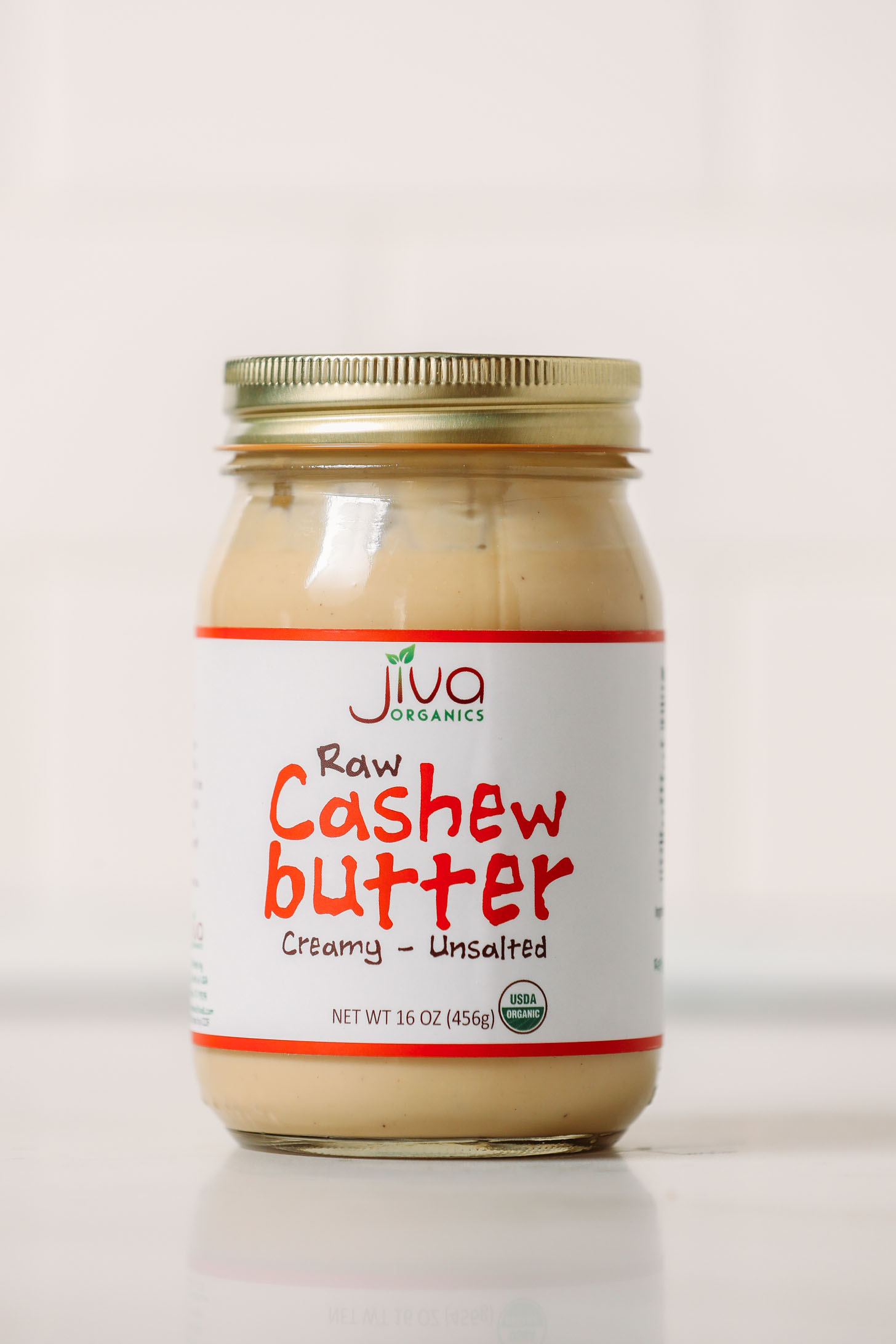
#1: Jiva Organics Raw Organic Cashew Butter
Stir-ability: 5 – literally no separation and incredibly smooth. No stirring required.
Taste: 5 – whoa, this is obviously high-quality stuff! You can taste the cashews just as you would if you were eating a handful of cashews! Tastes like there’s vanilla added, but there’s not. Perfection.
Texture: 5 – Incredibly rich and creamy. Coats the tongue.
Overall thoughts: 5 – ours had no safety seal, which was the only disappointment. The jar was noticeably sealed as it “popped” when opened. The flavor, texture, and quality are on point!
Approximate cost per ounce: $1.19
Added oils or salt: None
Raw or roasted: Raw
Glass or plastic jar: Glass
Quality of ingredients (i.e. organic, non-GMO, etc.): Organic, Raw, Non-GMO
Overall score: 20/20
Would we repurchase? Yes!
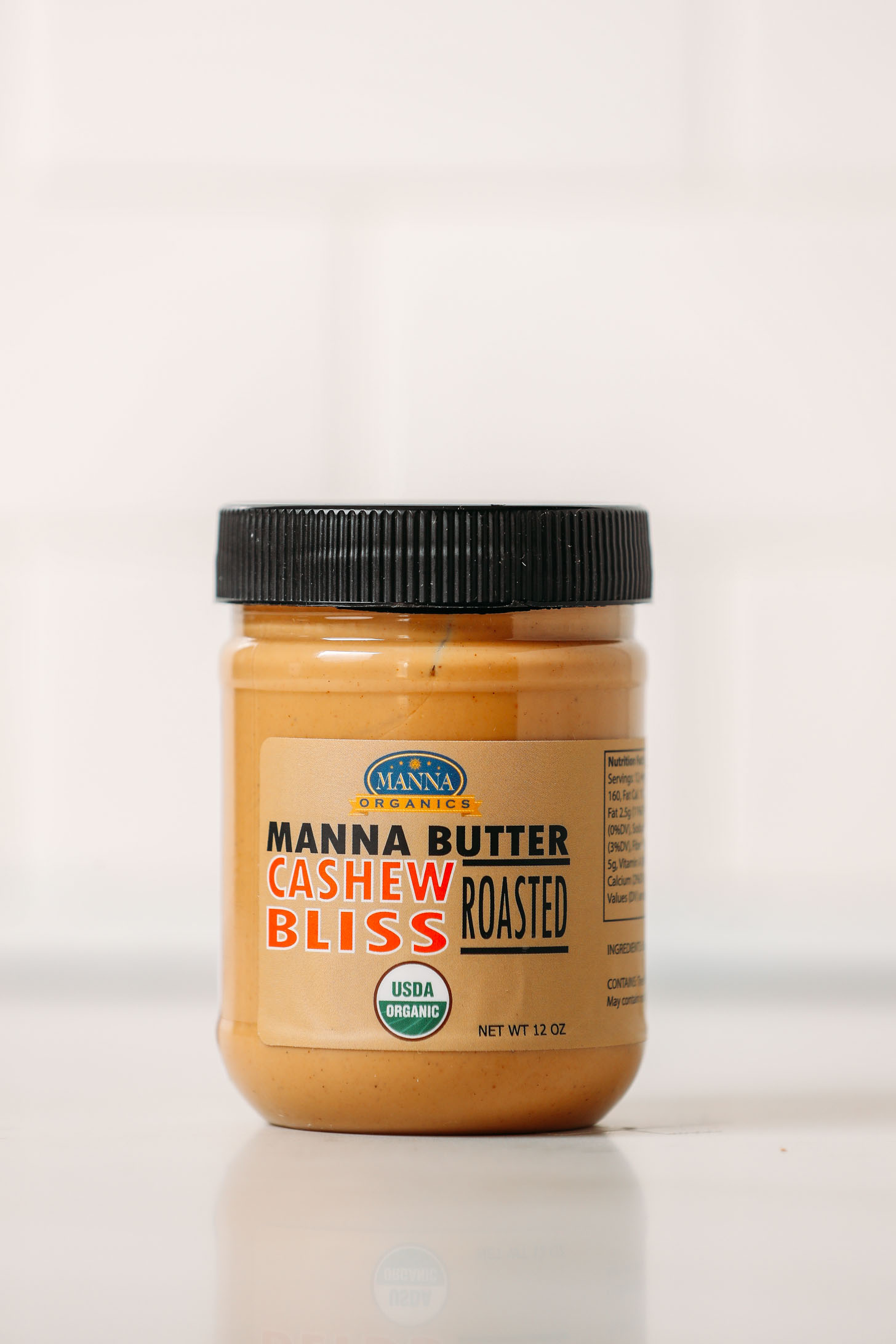
#2: Manna Organics – Manna Butter Roasted Cashew Bliss
Stir-ability: 5 – no stirring required and SUPER creamy.
Taste: 4 – really pleasant. No bitterness. It didn’t blow me away like Jiva, but overall really good!
Texture: 5 – very creamy.
Overall thoughts: 4.25 – great quality overall! I enjoyed the flavor and texture. It is a little on the runny side, but great overall.
Approximate cost per ounce: $1.58
Added oils or salt: None
Raw or roasted: Roasted
Glass or plastic jar: Plastic
Quality of ingredients (i.e. organic, non-GMO, etc.): Organic, Non-GMO
Overall score: 18.25/20
Would we repurchase? Yes
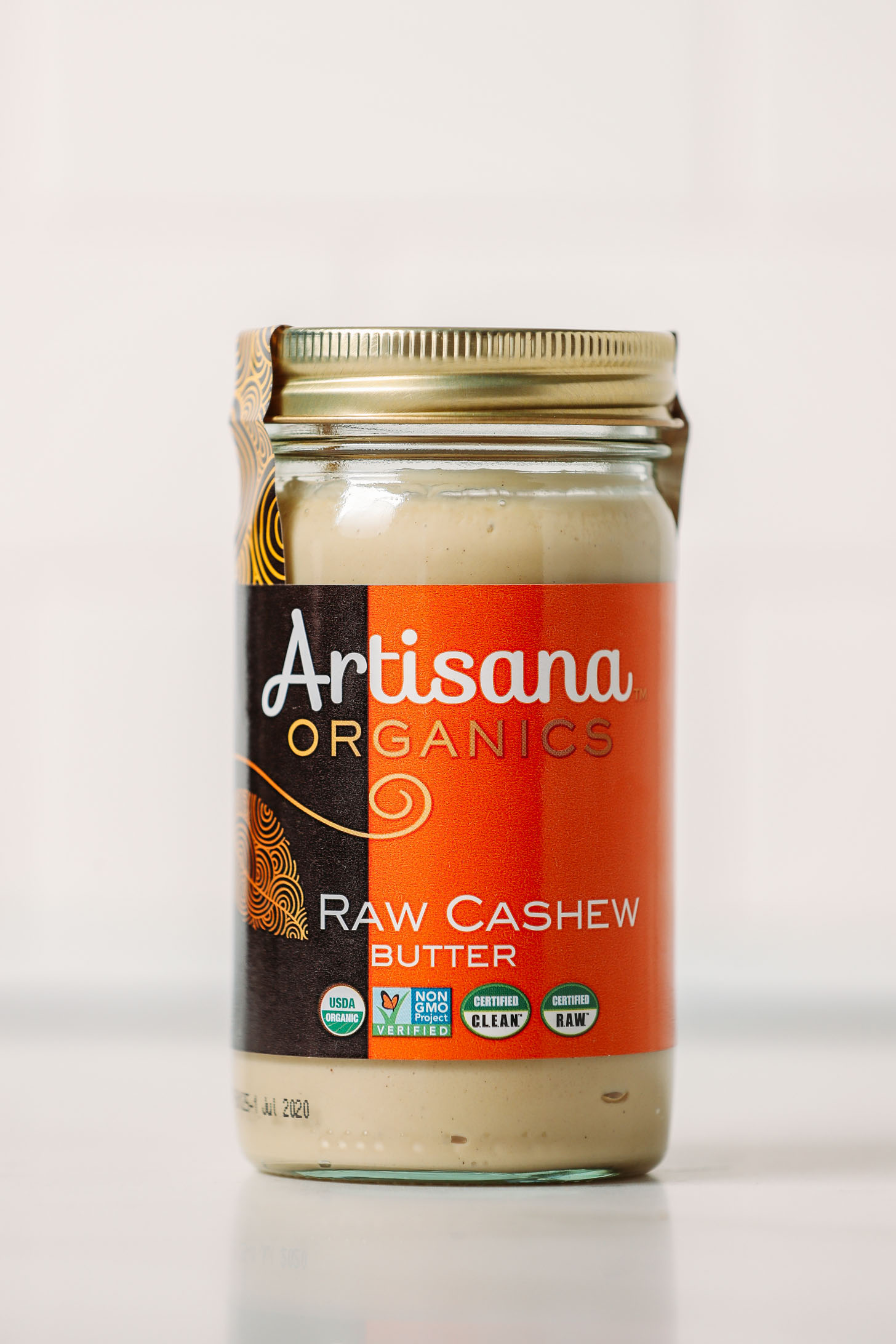
#3: Artisana Organics Raw Cashew Butter
Stir-ability: 4.5 – only slight separation. Visibly creamy, almost “mousse-like” texture after stirring.
Taste: 4 – somehow tastes slightly roasted. Not quite as good a flavor as Jiva, but still very enjoyable.
Texture: 5 – ridiculously creamy, rich, coats the tongue.
Overall thoughts: 4.25 – a great nut butter overall. Definitely high quality, creamy, and great flavor.
Approximate cost per ounce: $1.18
Added oils or salt: None
Raw or roasted: Raw
Glass or plastic jar: Glass
Quality of ingredients (i.e. organic, non-GMO, etc.): Organic, Non-GMO
Overall score: 17.75/20
Would we repurchase? Yes
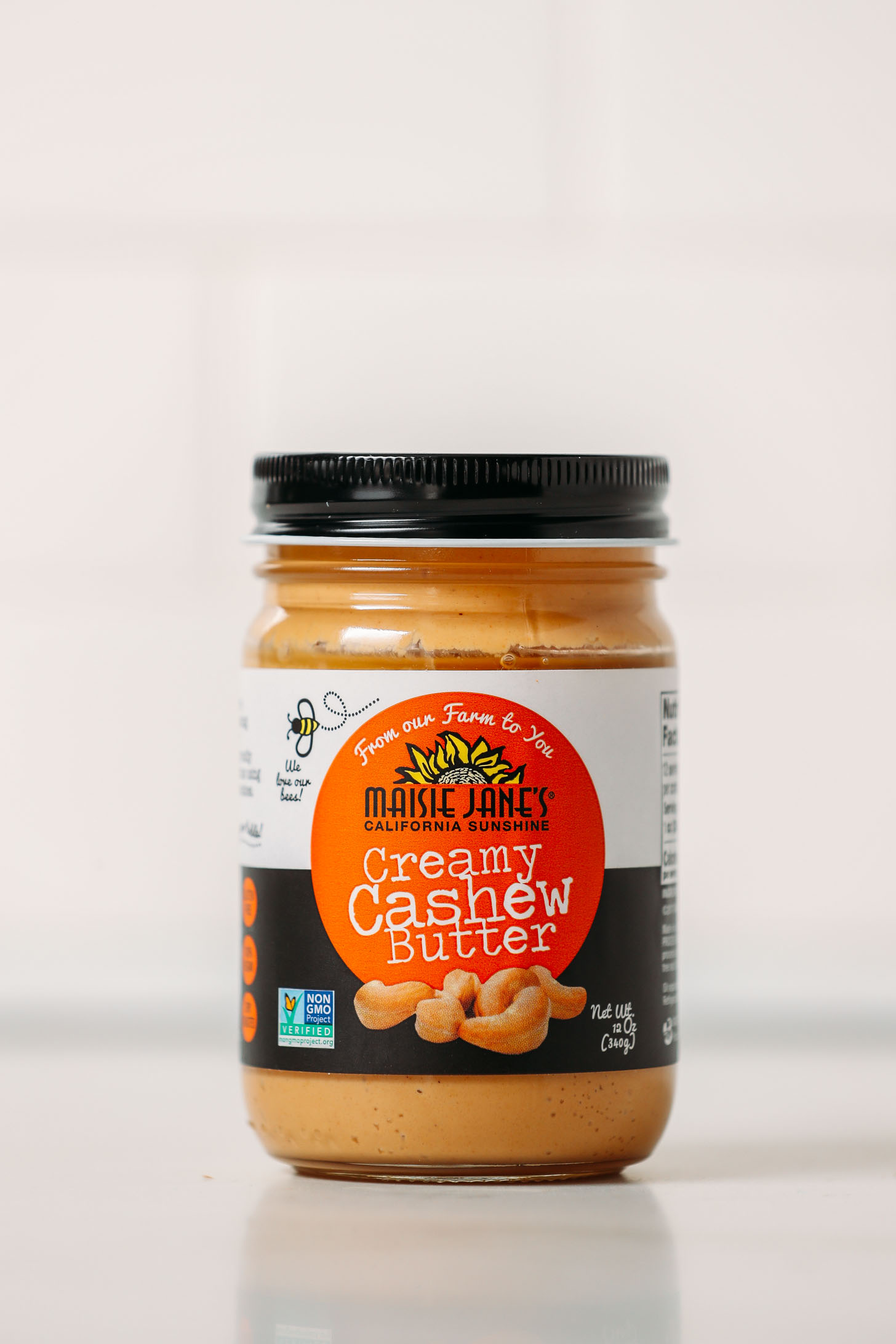
#4: Masie Jane’s Creamy Cashew Butter
Stir-ability: 4 – no separation, but a little thick. Overall easy to stir.
Taste: 4.5 – tastes like straight-up roasted cashews in the best way.
Texture: 4.5 – very creamy.
Overall thoughts: 4.5 – A classic, creamy, no-fuss cashew butter!
Approximate cost per ounce: $0.94
Added oils or salt: None
Raw or roasted: Roasted
Glass or plastic jar: Glass
Quality of ingredients (i.e. organic, non-GMO, etc.): Non-GMO
Overall score: 17.5
Would we repurchase? Yes
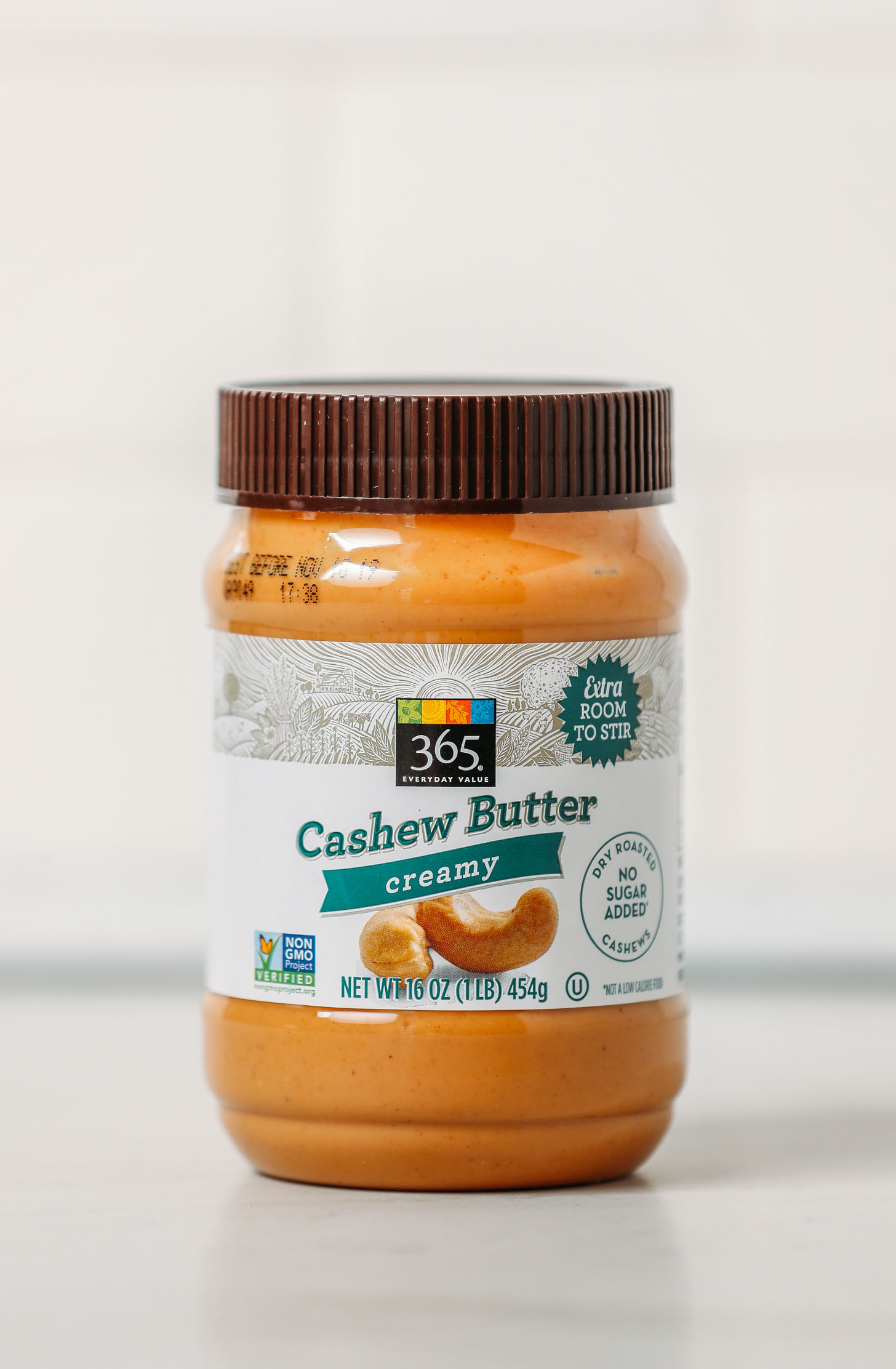
#5: Whole Foods 365 Cashew Butter – Creamy
Stir-ability: 5 – little to no separation, visibly creamy, and really easy to stir (no chunkiness)
Taste: 3.75 – pretty good. A little on the bland side. But overall pleasant.
Texture: 4.5 – super creamy, light, buttery, and only slight grittiness.
Overall thoughts: 3.75 – pretty close to homemade, but I feel like I get mine smoother at home. The taste was good, but nothing to write home about.
Approximate cost per ounce: $0.56
Added oils or salt: Expeller pressed safflower seed oil
Raw or roasted: Roasted
Glass or plastic jar: Plastic
Quality of ingredients (i.e. organic, non-GMO, etc.): Non-GMO
Overall score: 17/20
Would we repurchase? Yes
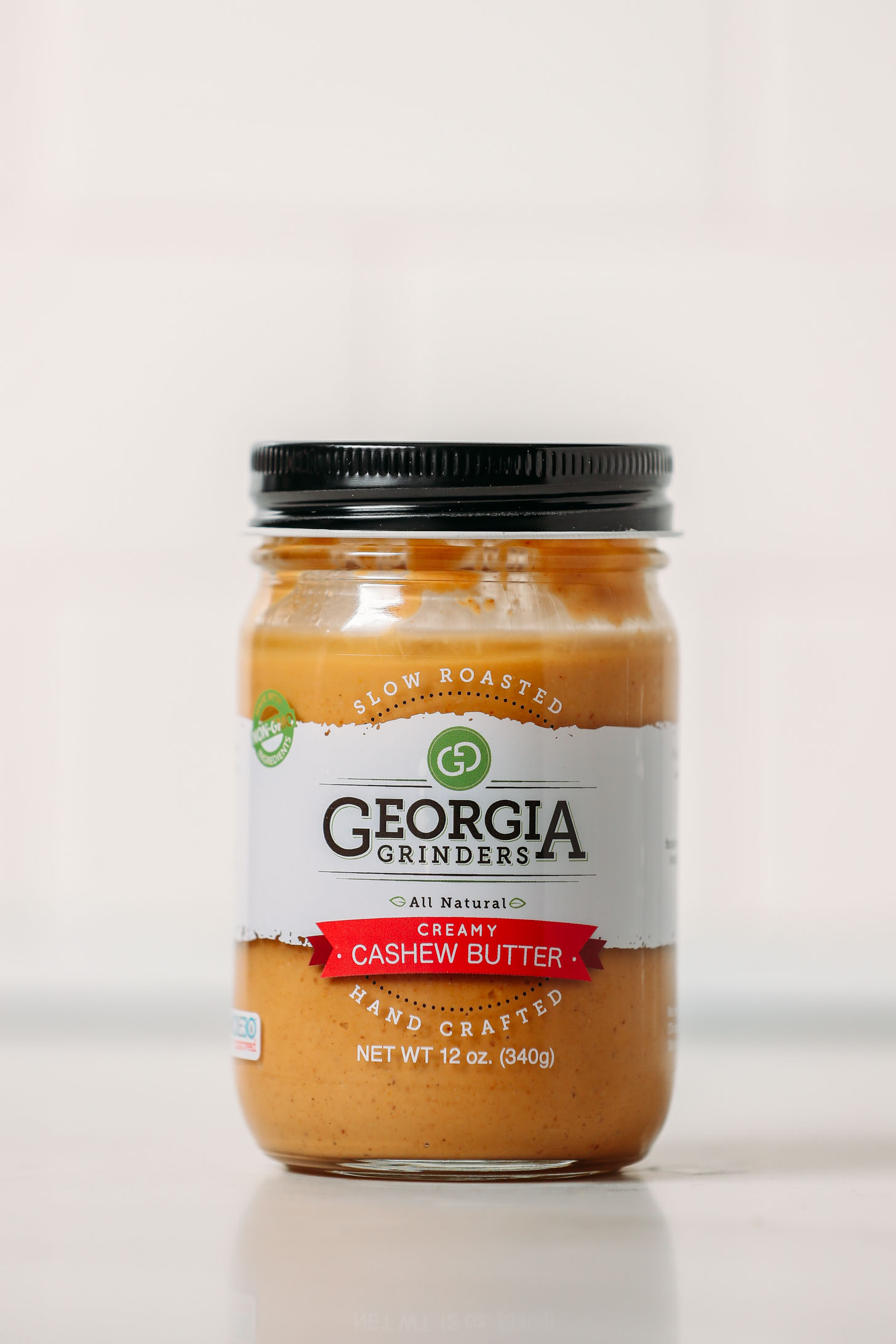
#6: Georgia Grinders Cashew Butter
Stir-ability: 4 – a little separation but overall easy to stir. Noticeable thick and thin parts.
Taste: 3.5 – good, not amazing. The salt was a nice touch, but the cashew flavor wasn’t nearly as prominent as some of the others.
Texture: 3.75 – creamy, slight grittiness (possibly from sea salt crystals).
Overall thoughts: 3.75 – a little underwhelming overall considering how much I’ve liked their other products. It’s good, just not something I’d run to repurchase.
Approximate cost per ounce: $1.83
Added oils or salt: Sea salt
Raw or roasted: Roasted
Glass or plastic jar: Glass
Quality of ingredients (i.e. organic, non-GMO, etc.): Non-GMO
Overall score: 15/20
Would we repurchase? Maybe
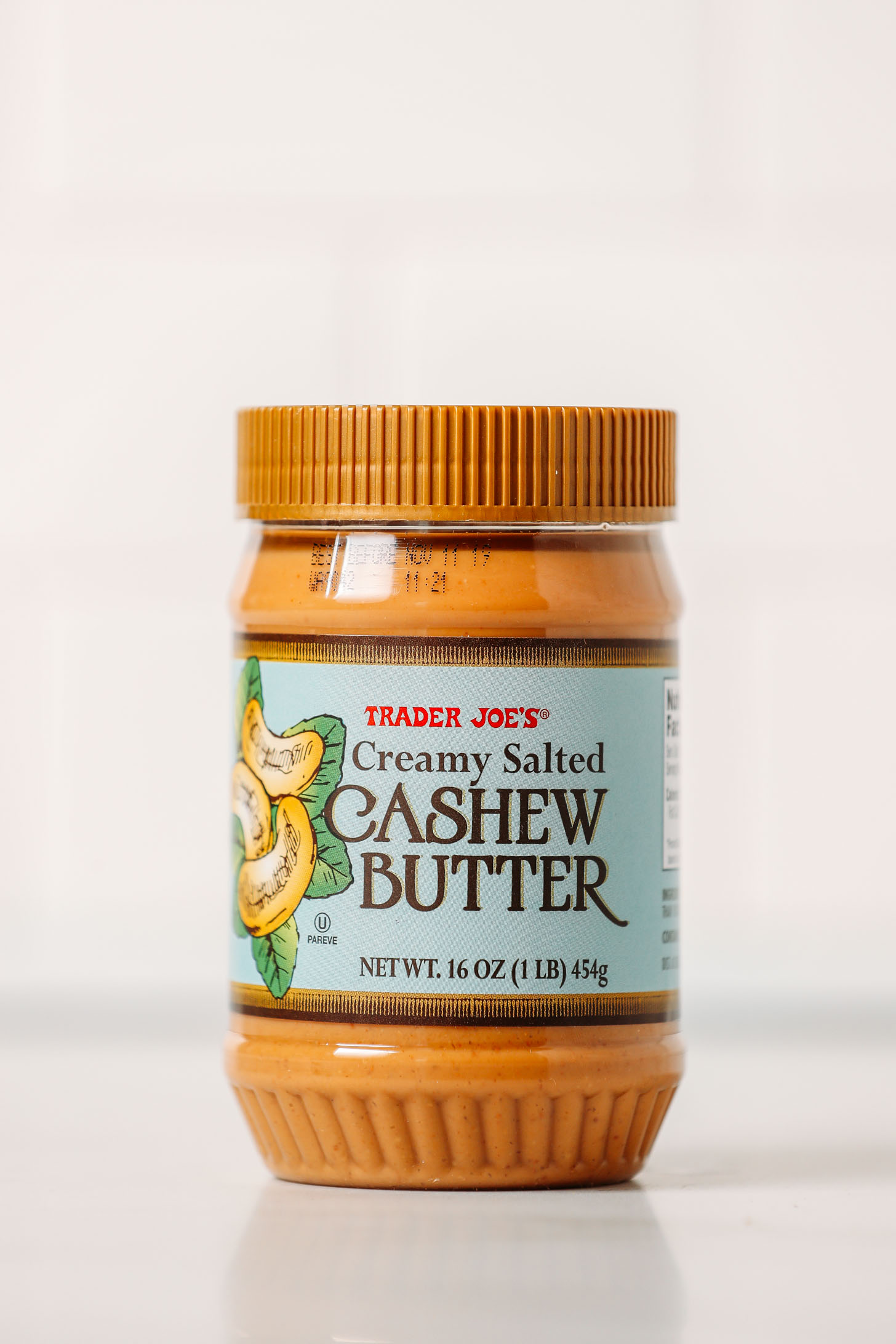
#7: Trader Joe’s Creamy Salted Cashew Butter
Stir-ability: 4.5 – little to no separation, visibly creamy, and really easy to stir (no chunkiness) — slightly oilier than Whole Foods.
Taste: 3 – over-salted so it overwhelms the cashew flavor. You can taste the oil.
Texture: 3.75 – looks creamy, but definitely has a noticeable grittiness to it.
Overall thoughts: 3 – promising texture. The taste was off.
Approximate cost per ounce: $0.44
Added oils or salt: Sunflower oil
Raw or roasted: Roasted
Glass or plastic jar: Plastic (BPA-Free)
Quality of ingredients (i.e. organic, non-GMO, etc.): Non-GMO
Overall score: 14.25/20
Would we repurchase? No
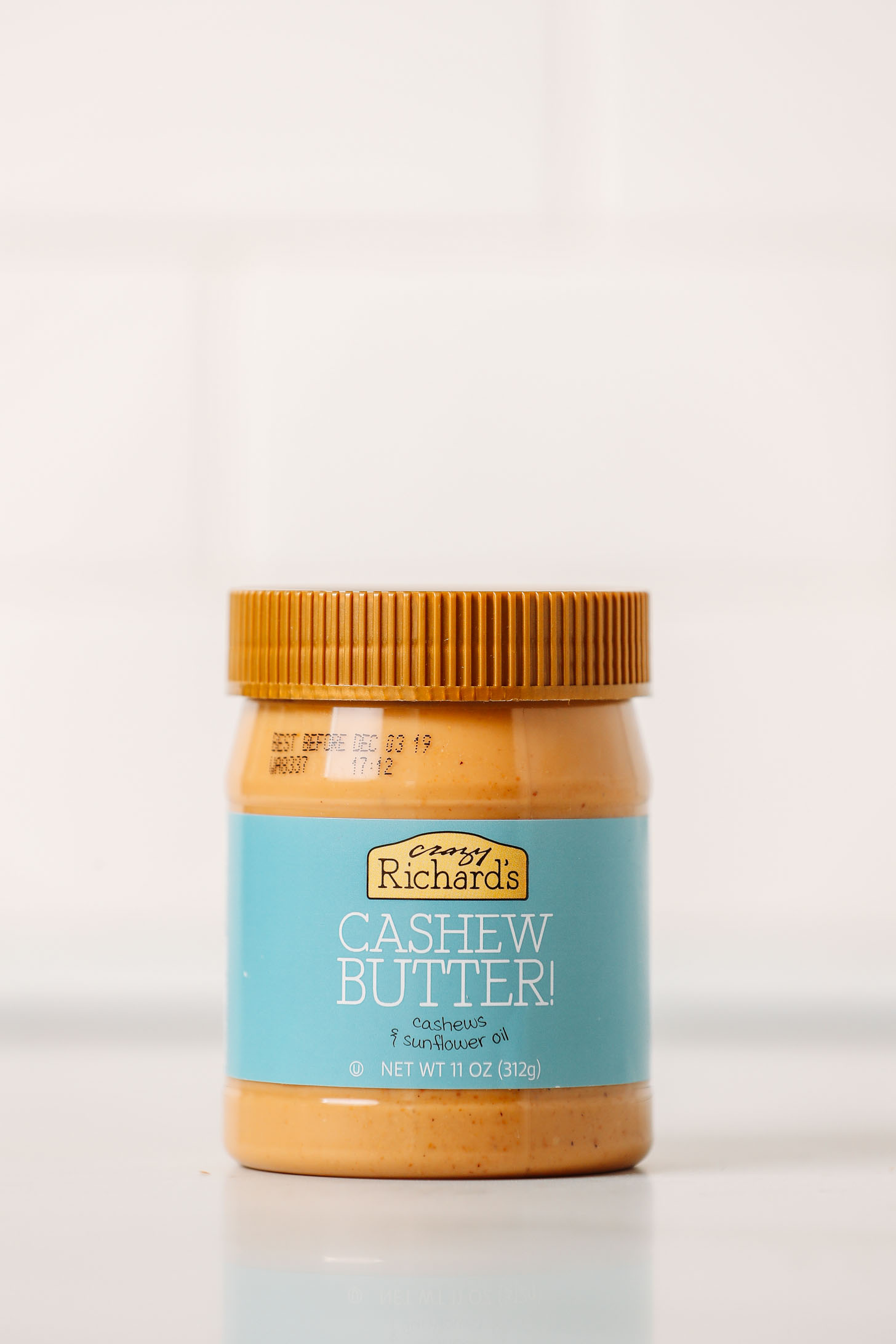
#8: Crazy Richard’s Cashew Butter
Stir-ability: 4.5 – very easy to stir, a little separation.
Taste: 2 – just bad. It tastes off. I suspect the oil is covering up the flavor of the cashews, which makes me think they aren’t high-quality nuts to begin with.
Texture: 4 – very creamy, only slight grittiness.
Overall thoughts: 2.75 – I wanted to like this one, but the taste was so off-putting I just couldn’t.
Approximate cost per ounce: $1.36
Added oils or salt: Sunflower oil
Raw or roasted: Roasted
Glass or plastic jar: Plastic (BPA-Free)
Quality of ingredients (i.e. organic, non-GMO, etc.): Non-GMO
Other: 10% of proceeds go to charity
Overall score: 13.25/20
Would we repurchase? No
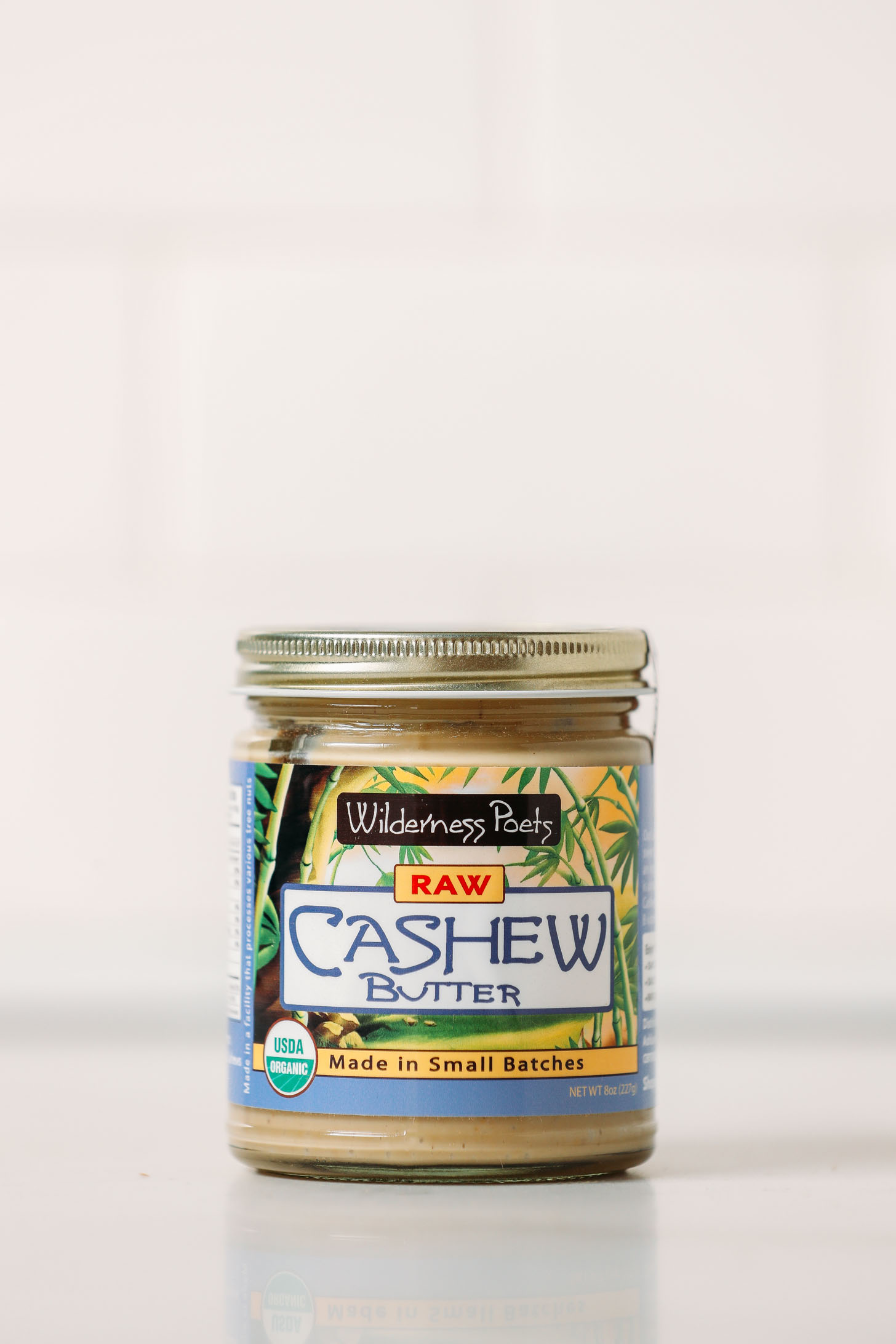
#9: Wilderness Poets Raw Cashew Butter
Stir-ability: 4 – no separation, but visibly a little gritty looking. However, easy to stir overall.
Taste: 2 – somehow quite bitter. Not pleasant.
Texture: 3.5 – creamy, but with little chunks of grittiness.
Overall thoughts: 2 – the taste I couldn’t get over. And then the texture was underwhelming, too.
Approximate cost per ounce: $2.00
Added oils or salt: None
Raw or roasted: Raw
Glass or plastic jar: Glass
Quality of ingredients (i.e. organic, non-GMO, etc.): Organic, Non-GMO
Overall score: 11.5/20
Would we repurchase? No
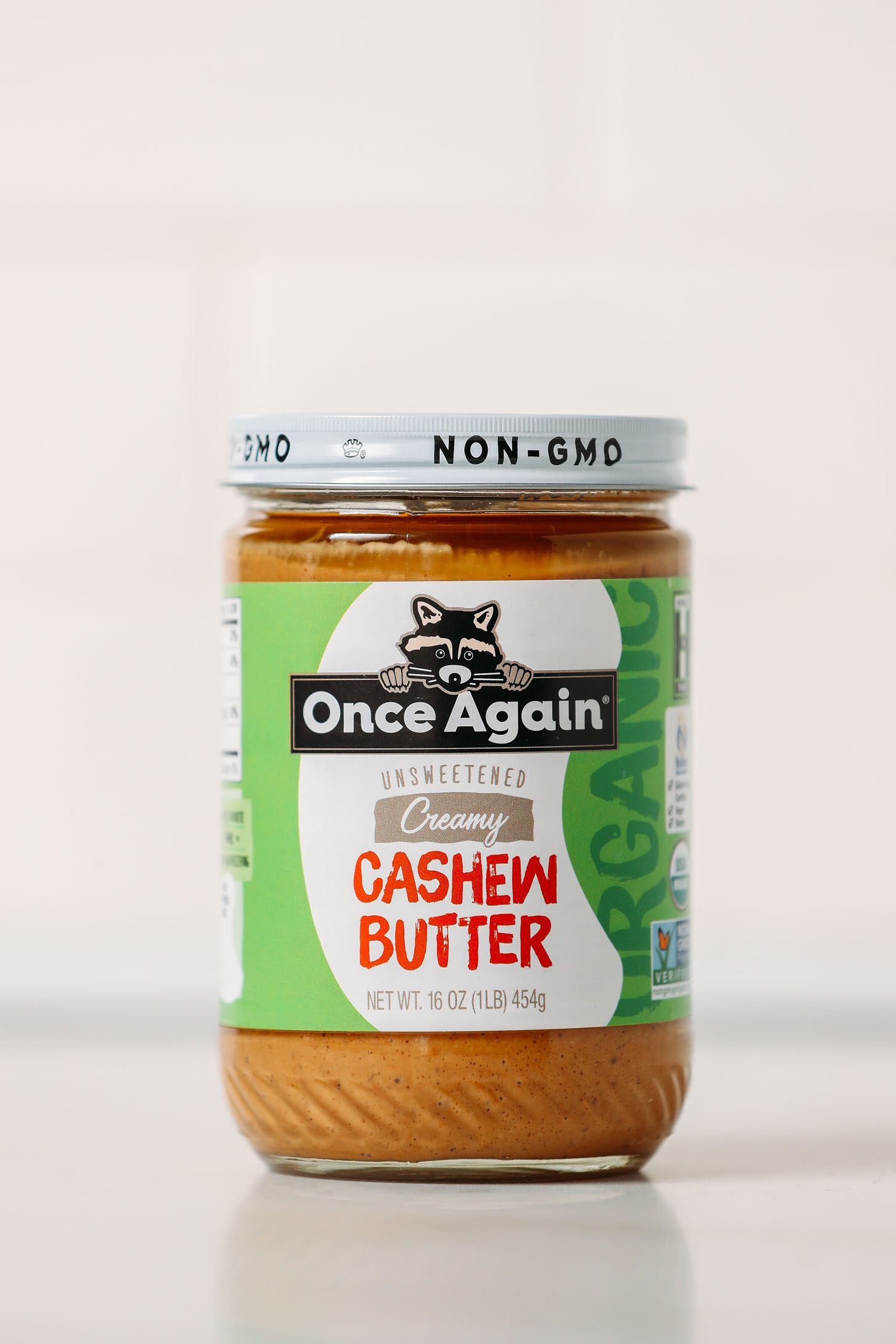
#10: Once Again Unsweetened Creamy Cashew Butter
Note: label design may vary
Stir-ability: 4.25 – a little separation, but overall visibly creamy and quite easy to stir.
Taste: 1.75 – it tasted off — almost rancid. Very bitter and unpleasant.
Texture: 3 – gritty.
Overall thoughts: 2 – would not recommend this one at all.
Approximate cost per ounce: $1.17
Added oils or salt: Sunflower oil
Raw or roasted: Raw
Glass or plastic jar: Glass
Quality of ingredients (i.e. organic, non-GMO, etc.): Organic, Non-GMO
Overall score: 11/20
Would we repurchase? No
HOW TO USE CASHEW BUTTER
Now that you know the best cashew butter on the block, put it to good use!
We enjoy cashew butter by the spoonful, on toast, on apple slices, and in recipes such as our Vegan Matcha Bliss Balls, 5-Ingredient Golden Milk Snack Bites, 20-Minute Asian Kale Salad, and Cashew Dipping Sauce. It can also be used as a substitute for other nut butters (such as peanut butter) in many recipes.
Into product reviews? Be sure to check out our Plant-Based Vanilla Protein Powder Review, Flavored Protein Powder Review, Chocolate Protein Powder Review, and Plant-Based Protein Bar Review!
We hope you enjoyed this cashew butter review! Let us know what other brands you love in the comments below!
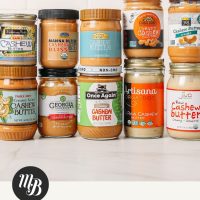

Maggie says
Very interesting that the same food can have such overwhelming differences. Many of the brands I’ve never tried but Once Again coming in last place was surprising. I usually try to shop bulk at our local food co-op or health food store and have been pretty happy. Love your recipes, always my first go to website. Use your cookbook regularly too.
Thank you for sharing your experience, Maggie! We’re so glad you enjoy our website and cookbook! xo
Paul Danilewski says
Great overview. Thanks so much. Only thing missing on each item is where you can purchase the item. Other surveys like this one have included the “where to purchase” information.
Hi Paul, with the exception of the Trader Joe’s and Whole Foods brands, these were all purchased from Amazon for accessibility. Hope that helps!
Cynthia Goss says
Just bought the Trader Joe’s cashew butter, really salty, too much for me. I usually just buy cashew butter from the grocery store, couldn’t even tell you the brands, but all were good and not salty.
Thanks for sharing! It’s not our favorite either.
Michelle says
This is such great information! I have been buying Trader Joe’s Cashew Butter. Clearly I am missing out on the good stuff! I know this is an old post, so not sure if you are still reviewing comments .
Have you tried baking with any of these cashew butters? I am looking for a substitute for non-natural peanut butters (aka Jif or Skippy). My daughter has a peanut allergy, and cashew butter is a good substitute flavor-wise, but know that natural vs. non-natural will impact the texture of baked goods.
Thank you!
Hi Michelle, Yes! We’ve baked with the Artisana. Hope that helps!
Lauren says
This is so helpful! I usually buy Artisana and use it when I don’t want to make my own cashew cream. I’ve been happy with it, I’m glad to know it’s a good one. I would really love a review like this for tahini! I’ve tried a couple that have clean ingredients lists, but taste awful. Some guidance there would be so helpful!!
Thanks for sharing! We LOVE Jiva :D
Tahini review coming soon!
Amina says
Dana!
Do you have a recipe for homemade cashew butter? I wanna make your 5 minute smoky chipotle dressing which calls for cashew butter but I’ve only got peanut butter on hand. I obviously have raw cashews on hand as well so just wondering if I can just make something real quick! Lmk!
Hi Amina, we don’t have a recipe for it, but you could use this as a guide. No need to roast them though!
Serena Sciallo says
Hi! Thank you so much for your reviews. I recently found Vor Cashew butter and it is delish! Raw cashews are the only ingredient (found through thrive.com). If you try it, let me know your thoughts!
Hi Serena, We’re so glad you find the reviews helpful. Thanks for letting us know about Vor! We haven’t tried it.
Linda C says
I was told by my dietician/nutritionist to beware of cashews as they have a high mold content. I appreciate the fact that you compared brands as I have always purchased #10 until I recently learned what my dietician/nutritionist had to say. Now I’m on the fence.
Thank you for the review and for all you do.
Thanks for sharing!
Ashley says
Do you have any other reviews besides the powders? I would LOVE to see the reviews on peanut butters, vegan cheese products, etc. I love your page!!!
Hi Ashley, we’re so glad you find the reviews helpful! You can find all of our reviews here (more coming soon!): https://minimalistbaker.com/reviews/
Lily says
Where can you get the Jiva in Vancouver?
Hmm, not sure there. But we’d probably recommend trying to get it online!